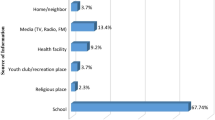Abstract
Interpersonal relations between health care providers and young clients have long being cited as an important element for improving client up take of services, satisfaction and overall health outcomes. In an era of HIV and AIDS this forms a critical determinant to young people accessing sexual and reproductive health care. This study explores to what extent interpersonal relations form a barrier to young peoples access to and satisfaction of health services. The study draws on data from 200 client exit interviews and four in-depth interviews conducted with university students and university health care staff in Kwazulu-Natal, South Africa. While young people are aware of the importance of utilising STI, HIV and family planning services they experienced barriers in their relationship with providers. This served as a deterrent to their use of the health facility. Adequate training in interpersonal relations for youth-friendly service provision is essential in helping overcome communication problems and enabling providers to interact with young clients at a more personal level.
Similar content being viewed by others
References
United National Population Fund. (2009). Fact sheet: Young people and times of change. Available from http://www.unfpa.org/public/cache/offonce/factsheets/young_people. Accessed on January 10, 2011.
Bearinger, L. H., Sieving, R. E., Ferguson, J., & Sharma, V. (2007). Global perspectives on the sexual and reproductive health of adolescents: Patterns, prevention and potential. The Lancet, 369, 1220–1231.
Tylee, A., Haller, D. M., Graham, T., Churchill, R., & Sanci, L. A. (2007). Youth-friendly primary-care services: How are we doing and what more needs to be done? The Lancet, 369, 1565–1573.
Senderowitz, J. (1997). Reproductive health outreach programs for young adults. FOCUS on young adults research series, 1–45. http://pf.convio.com/pf/pubs/focus/RPPS-Papers/outreach.pdf. Accessed on January 10, 2011.
Petroni, S. (2007). Improving youth sexual and reproductive health in the developing world: An evidence-based approach. http://www.summitfund.org/foundation/pdfs/ASRH-findings.pdf. Accessed on January 10, 2011.
Askew, I., & Berer, M. (2003). The contribution of sexual and reproductive health services to the fight against HIV/AIDS: A review. Reproductive Health Matters, 11(22), 51–73.
WHO. (2010). Social determinants of sexual and reproductive health: Informing future research and programme implementation. Geneva: World Health Organisation.
Smit, J., Beksinska, M., Ramkissoon, A., Kunene, B., & Penn, K. L. (2004). Reproductive health. South African Health Review, 2003, 59–81.
Marston, C., & King, E. (2006). Factors that shape young peoples sexual behaviour: A systemaic review. The Lancet, 368, 1582–1586.
Boonstra, H. D. (2008). Despite consensus and mounting evidence, challenges to improved HIV-reproductive health linkages remain. Guttmacher Policy Review, 11(4), 7–10.
Bruce, J. (1990). Fundamental elements of quality of care: A simple framework. Studies in Family Planning, 21(2), 61–91.
Shisana, O., Rehle, T., Simbayi, L. C., et al. (2009). South African national HIV prevalence, incidence, behaviour and communication survey 2008: A turning tide among teenagers?. Cape Town: HSRC Press.
Statistics South Africa. (2010). Mid-year population estimates 2010. Pretoria: Statistical Release.
KwaZulu-Natal Department of Health. (2010). Strategic plan 2010–2014. Available from http://www.kznhealth.gov.za/stratplan2010-14.pdf. Accessed on January 10, 2011.
Department of Health. (2003). District health information system database. Pretoria: Department of Health.
Nshindano, C., & Maharaj, P. (2008). Reasons for multiple sexual partnerships: Perspectives of young people in Zambia. African Journal of AIDS Research, 7(1), 37–44.
Ndhlovu, L., Searle, C., Miller, R., Fisher, A., Snyman, E., & Sloan, N. (2003). Reproductive health services in KwaZulu-Natal, South Africa: A situation analysis study focussing on HIV/AIDS services. Horizons Programme. Final Report. Washington DC: Population Council.
Maharaj, P., & Cleland, J. (2005). Integration of sexual and reproductive health services in KwaZulu-Natal, South Africa. Health Policy and Planning, 20, 310–318.
Berer, M. (2006). Dual protection: More needed than practiced or understood. Reproductive Health Matters, 14(28), 162–170.
Fleischman, J. (2006). Integrating reproductive health and HIV/AIDS programs. The Center for Strategic and International Studies. Available from http://csis.org/files/media/csis/pubs/060712_hivaids.pdf. Accessed on August 11, 2009.
Bharat, S. V., & Mahendra, V. S. (2007). Meeting the sexual and reproductive health needs of people living with HIV: Challenges for health care providers. Reproductive Health Matters, 15(29), 93–112.
Acknowledgments
We wish to acknowledge the support of the University Of KwaZulu-Natal and thank all participants in the study.
Conflict of interest
None.
Author information
Authors and Affiliations
Corresponding author
Rights and permissions
About this article
Cite this article
Alli, F., Maharaj, P. & Vawda, M.Y. Interpersonal Relations Between Health Care Workers and Young Clients: Barriers to Accessing Sexual and Reproductive Health Care. J Community Health 38, 150–155 (2013). https://doi.org/10.1007/s10900-012-9595-3
Published:
Issue Date:
DOI: https://doi.org/10.1007/s10900-012-9595-3



